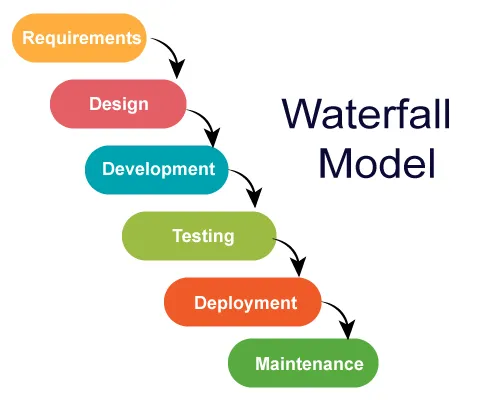What is Waterfall Model
The Waterfall Model is a linear and sequential approach to software development. This means that the project progresses through a set of predefined phases, and each phase must be completed before the next one begins. It’s called “Waterfall” because progress flows steadily downward, like a waterfall, through various phases.
Phases of Waterfall Model
Requirement Gathering and Analysis
This is the first phase in which detailed requirements of the software system to be developed are collected from the client. These requirements are documented in detail and will be used in the subsequent phases.
System Design
Using the requirements gathered in the first phase, the system design is prepared. This phase helps in specifying hardware and system requirements, and also helps in defining the overall system architecture.
Implementation
In this phase, the actual code is developed for the software. The design prepared in the previous phase is realized in code using a suitable programming language.
Integration and Testing
After the code is developed, it’s tested against the requirements to make sure that the product is actually solving the needs it was built for. This phase involves unit testing, integration testing, and system testing.
Deployment
Once the product has passed the testing phase, it is deployed in the production environment for the end-users.
Maintenance
Post-deployment, the product enters the maintenance phase where it will be maintained and upgraded as required to prevent or fix issues.
Advantages of Waterfall Model
The Waterfall model, despite some criticisms, still holds certain advantages which make it appealing for certain types of projects. Here are some of the notable advantages:
-
Clear Structure and Simplicity
The Waterfall model's linear nature makes it exceptionally simple and easy to use. Each phase has specific deliverables and a review process which allows for ease in understanding and implementing. -
Emphasis on Documentation
Since documentation is produced at every phase, this can be beneficial for the maintenance and future development of the project, especially when there are team changes or new members. -
Defined Endpoints
The Waterfall model is good for projects with clear objectives and end goals. Once the requirements are gathered and analyzed, there are fewer chances for scope creep as the project progresses. -
Ease of Management
Due to its linear structure, project scheduling and management are often easier compared to more iterative methodologies. -
High Visibility of Project Progress
Stakeholders can easily understand the current phase of the project, and what has been completed, based on the phase-based structure of the Waterfall model.
Disadvantages and Criticisms
Although the Waterfall model has its benefits, it has faced criticisms and shows certain disadvantages especially in today’s fast-paced and often uncertain development environments.
-
Difficulty in Accommodating Changes
Once the project progresses beyond a phase, it is difficult to go back and make changes. This lack of flexibility can lead to problems in accommodating changing customer requirements or market conditions. -
Late Testing Phase
Testing is done after the development phase is complete. This often means that bugs and issues are discovered quite late in the process, which can make them more costly and time-consuming to fix. -
Uncertainty and Risk
The Waterfall model assumes that all requirements can be gathered upfront. This is often not practical, and as a result, important issues may not be discovered until the project is well underway. -
Not Ideal for Complex or Innovative Projects
For large-scale, complex, or innovative projects where requirements may evolve, the rigidity of the Waterfall model is often counterproductive. -
Overemphasis on Documentation
While documentation is important, the Waterfall model sometimes puts too much emphasis on “contract negotiation” rather than working software and customer collaboration.
